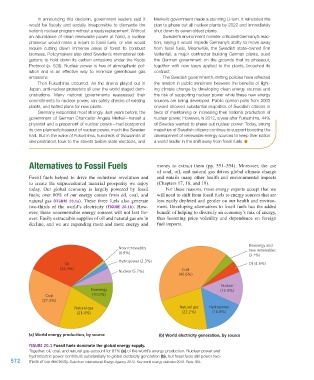Page 573 - Environment: The Science Behind the Stories
P. 573
In announcing this decision, government leaders said it Merkel’s government made a stunning U-turn. It reinstated the
would be fiscally and socially irresponsible to dismantle the plan to phase out all nuclear plants by 2022 and immediately
nation’s nuclear program without a ready replacement. Without shut down its seven oldest plants.
an abundance of clean renewable power at hand, a nuclear Sweden’s environment minister criticized Germany’s reac-
phaseout would mean a return to fossil fuels, or else would tion, saying it would impede Germany’s ability to move away
require cutting down immense areas of forest to combust from fossil fuels. Meanwhile, the Swedish state–owned firm
biomass. Policymakers also cited Sweden’s international obli- Vattenfall, a major contractor building German plants, sued
gations to hold down its carbon emissions under the Kyoto the German government on the grounds that its phaseout,
Protocol (p. 528). Nuclear power is free of atmospheric pol- together with new taxes applied to the plants, breached its
lution and is an effective way to minimize greenhouse gas contract.
emissions. The Swedish government’s shifting policies have reflected
Then Fukushima occurred. As the drama played out in the tension in public sentiment between the benefits of fight-
Japan, anti-nuclear protestors all over the world staged dem- ing climate change by developing clean energy sources and
onstrations. Many national governments reassessed their the risk of supporting nuclear power while these new energy
commitments to nuclear power, ran safety checks of existing sources are being developed. Public opinion polls from 2003
plants, and halted plans for new plants. onward showed substantial majorities of Swedish citizens in
Germany responded most strongly. Just years before, the favor of maintaining or increasing their nation’s production of
government of German Chancellor Angela Merkel—herself a nuclear power. However, in 2012, a year after Fukushima, 44%
physicist and a proponent of nuclear power—had postponed of Swedes wanted to phase out nuclear power. Today, strong
its own planned phaseout of nuclear power, much like Sweden majorities of Swedish citizens continue to support boosting the
had. But in the wake of Fukushima, hundreds of thousands of development of renewable energy sources to keep their nation
demonstrators took to the streets before state elections, and a world leader in the shift away from fossil fuels. New renewables
(0.9%)
Hydropower (2.3%)
Oil
Alternatives to Fossil Fuels money to extract them (pp. 551–554). Moreover, the use
(32.4%)
Nuclear (5.7%)
of coal, oil, and natural gas drives global climate change
Fossil fuels helped to drive the industrial revolution and and entails many other health and environmental impacts
to create the unprecedented material prosperity we enjoy (Chapters 17, 18, and 19). Bioenergy
today. Our global economy is largely powered by fossil For these reasons, most energy experts accept that we
(10.0%)
Coal
fuels; over 80% of our energy comes from oil, coal, and will need to shift from fossil fuels to energy sources that are
(27.3%)
natural gas (FIGURE 20.1a). These three fuels also generate less easily depleted and gentler on our health and environ-
Natural gas
two-thirds of the world’s electricity (FIGURE 20.1b). How- ment. Developing alternatives to fossil fuels has the added
(21.4%)
ever, these nonrenewable energy sources will not last for- benefit of helping to diversify an economy’s mix of energy,
ever. Easily extractable supplies of oil and natural gas are in thus lessening price volatility and dependence on foreign
decline, and we are expending more and more energy and fuel imports.
(a) World energy production, by source
Bioenergy and
New renewables new renewables
(0.9%)
(3.7%)
Hydropower (2.3%)
Oil Oil (4.6%)
(32.4%) Coal
Nuclear (5.7%)
(40.6%)
Nuclear
Bioenergy (12.9%)
Coal (10.0%)
(27.3%)
Natural gas Natural gas Hydropower
(21.4%) (22.2%) (16.0%)
(a) World energy production, by source (b) World electricity generation, by source
FIGURE 20.1 Fossil fuels dominate the global energy supply.
Together, oil, coal, and natural gas account for 81% (a) of the world’s energy production. Nuclear power and
Bioenergy and
new renewables
hydroelectric power contribute substantially to global electricity generation (b), but fossil fuels still power two-
572 thirds of our electricity. Data from International Energy Agency, 2012. Key world energy statistics 2012. Paris: IEA.
(3.7%)
Oil (4.6%)
Coal
(40.6%)
Nuclear
M20_WITH7428_05_SE_C20.indd 572 (12.9%) 13/12/14 1:56 PM
Natural gas Hydropower
(22.2%) (16.0%)
(b) World electricity generation, by source

